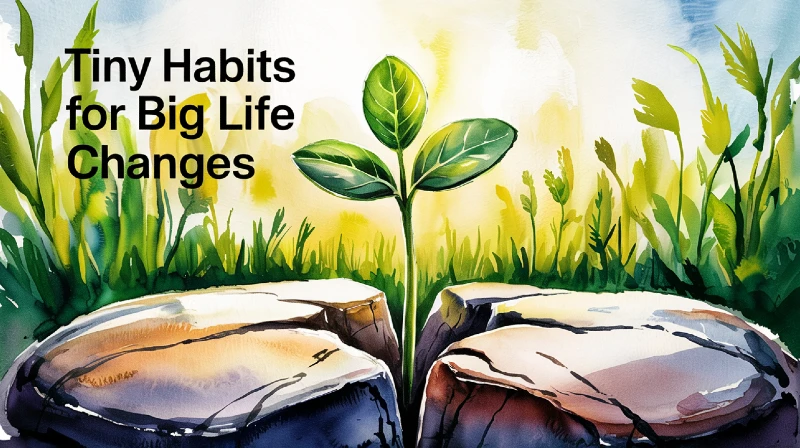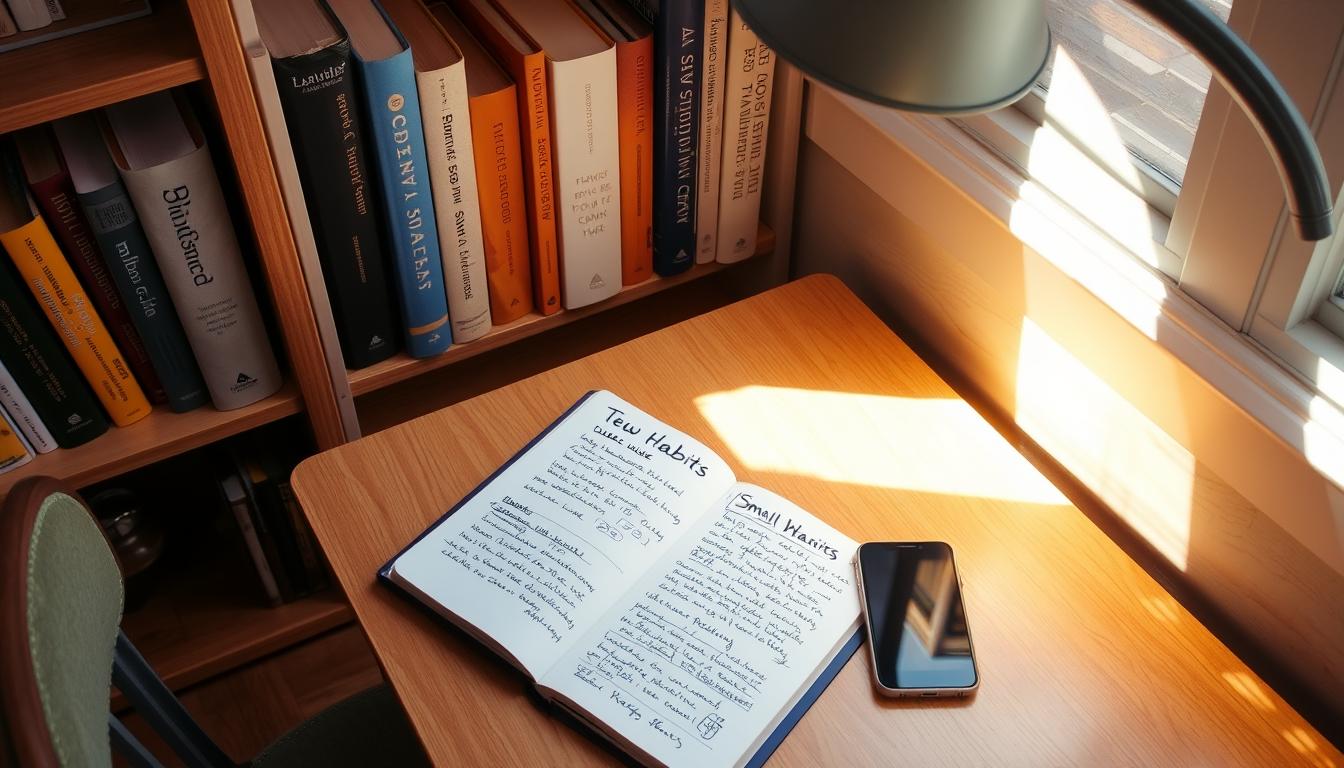Tiny Habits for Big Life Changes: Secrets to Transformation
Changing your life doesn’t need a big change. For 70% of people, the fear of big changes stops them. Tiny Habits for Big Life Changes offers a science-backed way. Dr. BJ Fogg’s research shows even small actions, like a 30-second exercise, can lead to lasting change.
His Tiny Habits Method, used at Stanford, helps avoid the overwhelm that traps 80% of people by February. It focuses on small, achievable steps.
Think about adding a 1-minute habit daily instead of big changes. Celebrating each tiny win boosts retention by 30%. By linking new habits to routines, like brushing teeth, you’re 40% more likely to keep them.
This method works because it skips the need for perfection. It focuses on what’s possible. Julie DeLucca-Collins, a habit expert on ABC and TEDx, shows how small steps can turn frustration into progress.
Key Takeaways
- Tiny Habits for Big Life Changes reduce overwhelm and boost success.
- Small changes big impact: Celebrate wins to boost habit retention by 30%.
- Anchor new actions to existing routines for a 40% higher success rate.
- Stanford-backed science shows simplicity beats motivation alone.
- Self-compassion increases habit return rates by 25% after slip-ups.

The Power Behind Tiny Habits for Big Life Changes
Big transformations often start with small, consistent actions. Like seeds growing into forests, daily micro-behaviors can lead to profound personal growth over time. Dr. BJ Fogg’s Tiny Habits method proves that beginning with small changes—like flossing just one tooth—can unlock major life improvements.
Why Small Actions Create Big Results
A simple action, such as drinking a glass of water first thing in the morning, can boost energy, sharpen focus, and set a positive tone for the day. Unlike lofty goals that feel overwhelming, tiny habits are easy to start—and easier to maintain. They help you shift your mindset from “I’ll never” to “I can.”
The Compounding Effect of Micro-Behaviors
Small habits build up fast. Consider:
Saving $5 a day = $1,825 per year
Reading 10 pages a night = 12 books annually
A 5-minute stretch = reduced stress and improved mobility
Just like compound interest, these small efforts multiply over time, creating lasting change with minimal stress.
Letting Go of the All-or-Nothing Mentality
Consistency beats perfection. Missing a day doesn’t mean failure—it’s part of the process. Restart tomorrow. Writing a single journal sentence a day may one day evolve into an entire book. The point is to keep moving, even in tiny steps.
The Science Behind Habit Formation
Understanding how habits form helps you build them more effectively. Our brains are wired to form routines, and repeated behaviors shape lasting neural connections.
The Neurological Power of Habits
Neuroplasticity—the brain’s ability to change—means every repeated action strengthens a neural pathway. Over time, habits become automatic. Studies show it takes an average of 66 days for a habit to stick. With 45% of daily behavior driven by habits, starting small makes big sense.
The Habit Loop: Cue → Craving → Response → Reward
According to Charles Duhigg in The Power of Habit, every habit follows a predictable pattern:
Cue: The trigger (e.g., waking up at 8 AM)
Craving: The motivation (e.g., need for energy)
Response: The action (e.g., brewing coffee)
Reward: The satisfaction (e.g., that caffeine kick)
By identifying and tweaking these components, you can create healthier routines with ease.
“The habit loop can be hacked to build positive routines.” — Charles Duhigg
Why Willpower Isn’t Enough
Willpower is finite. That’s why creating the right environment matters more than trying harder. In BJ Fogg’s studies, people using tiny habit strategies lost an average of 2kg in just 8 weeks—without relying on discipline alone.
Behavior change works best when your surroundings support your goals. Designing cues and rewarding systems makes change sustainable. In the end, the brain values consistency over intensity.
Starting Small: How to Identify the Right Tiny Habits
Choosing the right tiny habits starts with clarity. Ask yourself: What big goal feels overwhelming? Break it down using BJ Fogg’s framework. Focus on behaviors that meet three criteria: impactful, motivating, and achievable—even on your most hectic Monday.
- Impactful: Pick habits that nudge you toward goals. Want to read more? Start with flipping one page after brushing teeth.
- Motivating: Align habits with what excites you. Hate exercise? Try a 10-second stretch post-alarm.
- Doable: Make it effortless. Fogg’s research shows 30-second actions (like sipping water first thing) build momentum.
Use Fogg’s ABC method: Anchor a new habit to existing routines (e.g., “After work, walk for two minutes”). Behavior must be so simple you can’t say no—even if you’re exhausted. Celebratewith a quick cheer or fist pump. Celebrations trigger dopamine, reinforcing the habit loop.
“Celebration is the secret sauce,” says BJ Fogg. “Even a three-second “Yesss!” after finishing a push-up builds brain connections.”
His research shows celebrating tiny wins strengthens resolve faster than waiting for big results. Start with actions like “write one word daily” or “meditate for 5 breaths.” Over 300 examples in his method prove even one push-up a day leads to lasting change. Remember: develop new habits by focusing on consistency, not perfection. Let’s get started.
The BJ Fogg Method: Behavior Design That Works
Dr. BJ Fogg, founder of Stanford’s Behavior Design Lab, changed behavior change with his Tiny Habits method. He designs small actions that fit into our daily lives to create lasting habits. His method breaks down big goals into tiny steps, making them automatic.
Anchor Moments: Finding the Perfect Timing
Anchor moments are routines that trigger new habits. Link a tiny behavior to a regular habit like brushing teeth or lunch. Here are some examples:
- After morning coffee, do 3 deep breaths
- Before leaving a room, touch the doorframe (a physical anchor for mindfulness)
- After arriving home, hang keys on a hook
Celebration: The Secret Ingredient to Habit Success
Celebration is key, not optional, for forming habits. Fogg says the joy should happen immediately, like a fist pump or a quiet “Yes!”.
Waiting too long to praise yourself (like sending a message two days later) won’t work. As Fogg puts it:
“Celebration is habit fertilizer. Even if it feels silly, the emotion sticks.”
Simplicity Factors That Make Habits Stick
Fogg’s method focuses on three simplicity factors: time, effort, and clarity. Here’s how to use them:
| Factor | Action |
|---|---|
| Time | “10 seconds max” (e.g., 1 push-up) |
| Physical Effort | “One more step” (e.g., walk 1 extra block) |
| Mental Effort | Clear cues: “After lunch, I’ll drink water” |
By making habits ridiculously easy, motivation increases. Fogg’s research shows celebrating each small success keeps the momentum going—no need for willpower.
Habit Stacking: Building a Chain of Positive Behaviors
Habit stacking turns daily habits into powerful tools for growth. It links small new actions to routines you already do. This way, daily habits help each other grow. Think of brushing your teeth (a habit) and then flossing (a new habit) as a chain that makes progress easy.
- Pick a strong anchor: Choose a routine like morning coffee as your starting point.
- Add one new action: Attach a tiny behavior like stretching or journaling to this anchor.
- Chain for momentum: Once one habit sticks, attach another, like “After journaling, I’ll meditate.”
| Existing Habit | New Habit | Outcome |
|---|---|---|
| Brush teeth | Drink a glass of water | Hydration reminder |
| Check phone | Read one page | Weekly book completion |
| Commute | Listen to a podcast | Knowledge gain daily |
BJ Fogg’s research shows that linking new actions to habits you already do boosts success. “Linking behaviors to habits you already do makes change effortless,” explains behavioral scientists. Start small: Add only one new action at a time. If you skip twice, reset instead of quitting. Over time, these stacks become automatic, building routines that last.
“The brain strengthens pathways used daily—habit stacking leverages this to create lasting change.” —Melissa Ming Foynes, PhD
Pair this with the HIGH5 strengths test to align habits with personal traits. For example, a disciplined person might stack “After lunch, I’ll review goals” to boost focus. Track progress with checklists or calendar stickers for visual motivation. Remember: Consistency beats perfection. Every small step in your habit stacking system adds up over time.
Common Obstacles to Developing New Habits and How to Overcome Them

Starting new habits can be tough. Things like unclear goals or environments that don’t help can stop us. About 81%–92% of New Year’s resolutions fail because of these issues. But, we can turn these obstacles into chances to grow.
Environmental Design for Success
First, make your space support good habits. Keep your workout clothes by your bed for easy mornings. Get rid of things that distract you, like junk food from your kitchen counters. Studies show 75% of people find it hard to form habits in places that don’t change.
- Put reminders (like sticky notes) where you’ll see them every day.
- Swap out bad habits with tools that help you succeed (like apps that block social media during work).
“Motivation is a bad lever to push. Focus on ability and prompts instead.”
Managing Expectation and Progress
Don’t try to do too much too soon. It takes about 66 days for habits to become a part of your life. Use a calendar or app to track your progress. Celebrate your streaks, not just the big wins.
Expecting results right away can lead to quitting. Break down big goals into smaller steps. Start with one pushup a day, not 20.
Recovering From Habit Disruptions
It’s okay to slip up sometimes. If you miss a day, just start again. It’s normal to slip up 50% of the time. What’s important is getting back on track.
Use these setbacks to improve your plan. Maybe change your cues, make actions simpler, or make things more accessible. Remember, 70% of the time, disruptions come from bad planning, not lack of willpower.
Small changes can make a big difference. By working on your environment, goals, and how to bounce back, you can build lasting positive habits. You don’t need to rely on short-lived motivation.
Real-Life Success Stories: Small Changes, Big Impact
Everyday people show that small changes big impact are real. They’ve made fitness gains and career jumps through tiny habits. For example, drinking water first or giving compliments can change lives. These stories prove Tiny Habits for Big Life Changes work, without big changes.
| Habit | Time/Day | 6-Month Impact |
|---|---|---|
| Drink water + 2 push-ups | 1.5 minutes | 15 lbs lost, better sleep |
| 10 pages reading | 10 mins | 12 books/year, promotion earned |
| Daily compliment | 30 seconds | 30% fewer conflicts in relationships |
Health Transformations Through Tiny Steps
Aaron, a software engineer, started with a simple habit. He drank water and did two push-ups each day. After six months, he lost 15 pounds and slept better. He says, “It wasn’t magic—it was sticking to it.”
He made these habits part of his routine, like doing exercises after using the bathroom.
Career Advancement Through Daily Micro-Practices
- Lisa, a marketing pro, read 10 pages a day. She finished 14 books in a year. This helped her get a leadership role.
- Weekly emails praising a coworker’s work made Lisa more visible and helped her collaborate more.
Relationship Improvements Via Minimal Efforts
Mike’s marriage improved with a 5-minute daily ritual. They stopped fighting over chores. Research from UC Berkeley shows small daily affirmations can reduce fights by 30%.
These stories show starting small can lead to big changes. Whether it’s better sleep, skills, or relationships, the key is to start small and keep going. BJ Fogg says, “Habits built on joy, not guilt, last longest.”
Creating Your Personal Tiny Habits Roadmap
Building daily habits starts with a clear plan. Dr. Fogg’s ABC framework—Anchor, Behavior, Celebration—is your roadmap. Start by picking 1–3 tiny actions linked to your goals. For example, after brushing your teeth (anchor), do 2 push-ups (behavior), then celebrate with a fist pump (reward).
Follow this 30-day guide: Start with 1 habit for the first week. Use a timer or app to track progress. After two weeks, add another habit. By week three, introduce a third. Always keep behaviors so small they feel effortless.
Need motivation? Remember: Neuroplasticity means every tiny action strengthens your brain’s habit pathways.
- Anchor First: Pick routines you already do, like morning coffee or bedtime.
- Scale Gradually: After 21 days of consistency, increase habit difficulty. For example, add 1 minute of meditation daily.
- Environment Design: Place workout shoes near your door to trigger exercise routines.
- Celebrate Always: Celebrate every success—even if it’s just a silent “Nice job!”
Adults with ADHD? Start with 1 habit at a time. Use visual reminders or alarms to counter memory challenges. Celebrate tiny wins to boost dopamine and motivation. Remember: Consistency beats perfection.
By week 30, small changes compound into create lasting habits that reshape your life. Track progress with a simple checklist, not a spreadsheet. Adjust only when you’ve mastered the current habit. Your journey is unique—trust the process.
Conclusion: Embracing the Journey of Transformation Through Small Steps
Small actions can lead to big changes. habit formation is about making daily choices that help you reach your goals. Research shows that doing just 30 push-ups a day or adding one extra vegetable can make a big difference.
When you focus on habits for success, being consistent is more important than being perfect. Think of a penny doubling in value every day. Starting small can lead to huge gains, like earning $5 million in just 30 days.
Most people give up on New Year’s resolutions because they want too much too soon. The Tiny Habits method changes this. It starts with tiny actions, like stretching for five minutes, that are easy to do.
Over 10 years, cutting sugar from tea twice a day can greatly improve your health. These small changes can have a big impact.
Start today with a habit that feels easy. Celebrate every small win. These small victories will build your confidence and keep you moving forward.
Remember, even a small change in direction can make a big difference. Your journey starts with curiosity, not pressure. Create your path, adjust as needed, and trust the process. The key to habit formation is to start small, stay consistent, and let time work for you. Your future self will be grateful for that first step.
Frequently Asked Questions (FAQ)
What are “tiny habits” and how do they work?
Tiny habits are small, simple actions—like drinking a glass of water or writing one sentence—that are easy to do and repeat daily. The idea is that by starting small, you build momentum and consistency, leading to bigger changes over time.
How long does it take to form a habit?
Research shows that most habits become automatic after about 66 days of consistent practice. However, this can vary based on the habit’s complexity and individual differences.
Do I need motivation to start tiny habits?
No. One of the main benefits of tiny habits is that they don’t rely heavily on motivation. Because they’re easy to do, you’re more likely to stay consistent even when motivation dips.
What if I miss a day?
Missing a day is normal and doesn’t mean failure. The key is to start again the next day without guilt. Habit formation is about long-term consistency, not perfection.
Can tiny habits really create big life changes?
Yes. Tiny habits create a compounding effect—small, repeated actions lead to large results over time, just like saving money or building muscle.
How can I remember to do my tiny habit each day?
Use an existing habit as a trigger. For example, if you want to start stretching, do it right after brushing your teeth. This builds a mental connection and helps make the habit stick.

Sharon Molly is a content creator in lifestyle, fashion, and travel, delivering style-savvy advice and destination insights to inspire confident living. With a background in digital media, she combines aesthetics with practical guidance for modern women on the go.




